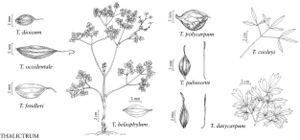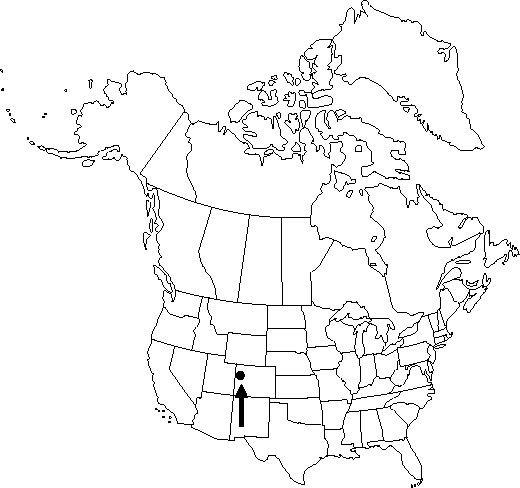Thalictrum heliophilum
Brittonia 35: 156. 1983.
Roots fibrous. Stems 14-50 cm, arising singly or in dense clusters of 2-3 from short, horizontal, fibrous-rooted rhizomes. Leaves basal and cauline, petiolate. Leaf-blade ternately compound, cauline blades gradually reduced upward, distalmost 2-ternate; leaflets broadly obovate, apically 3-toothed, otherwise undivided, 5-8 × 4-5 mm, leathery, surfaces glabrous, glaucous. Inflorescences terminal, panicles, many flowered. Flowers: sepals 4, color unknown, lanceolate to ovate, 2-3 mm; filaments brownish, 2-3 mm; anthers 2-3 mm, apiculate; stigma color unknown. Achenes 4-5 (-6), not reflexed, nearly sessile; stipe 0.1-0.2 mm; body oblique-obovate, strongly laterally compressed, 4-5 mm, glabrous, glaucous, prominently 3-veined on each side, veins converging near apex, rarely branched or sinuous, not anastomosing-reticulate; beak ca. 1.5 mm.
Phenology: Flowering summer–summer (Jun–Aug).
Habitat: Decomposing shale of Green River Formation
Elevation: 2500 m
Discussion
Of conservation concern.
In a genus of primarily mesophytic plants, Thalictrum heliophilum is notable for its relatively xeric habitat. Known only from Garfield and Rio Blanco counties, northwestern Colorado, it is similar to the widespread T. fendleri; it may be distinguished by its smaller, leathery, glaucous leaflets and fewer achenes.
Selected References
None.

